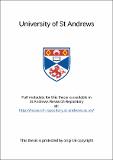Computer graphic manipulations in the study of face perceptions
Abstract
The face is of unparalleled importance in communication, containing cues used not only in identity recognition but, also for the assessment of character, mood, health and attractiveness. Computer graphic image (CGI) manipulation has enabled the effects of facial cues on perception to be studied from cognitive neuroscience and evolutionary psychology perspectives. A set of studies employing novel computer graphic methods to investigate facial expression, symmetry and dynamic cues related to taste is presented in six experimental chapters (2-7). In Chapter 2 novel photo-realistic stimuli are employed to study the perceptual lateralization of facial cues for perceptions of age, gender, attractiveness, expression and lip-reading. Results suggest a right hemisphere lateralization for all perceptions except lip-reading, which appears left lateralized. Previous studies with photographic and CGI manipulations have implied that humans unlike other animals prefer asymmetry in attractiveness judgements. In Chapter 3, new, more appropriate, CGI techniques were applied to investigate facial symmetry preference. In a series of experiments humans were found to judge more symmetrical faces as more attractive and possible individuals differences in symmetry preference strength were investigated. CGI techniques have enabled consistent qualities related to attractiveness and age to be captured from groups of face images and subsequently manipulated. In Chapter 4, these techniques are applied to capture and manipulate qualities associated with perceived skin health. Chapter 5 represents a foray into dynamic cues related to food consumption using video. Possible facial cues to the strength, taste and the hedonic value of flavours that an observed individual was consuming were investigated. Chapter 6 presents a novel test investigating individual differences in the percept of neutral expression. To illustrate the test: when asked to make faces expressively neutral, depressed individuals chose higher levels anger and disgust compared to controls. The test used novel 'anti-face' expression stimuli. These were later used in Chapter 7 to investigate a recent finding that adaptation to the anti-faces of individuals (faces with the opposite characteristics to a particular individual), facilitated recognition of subsequently presented corresponding individuals. The presence of analogous effects for emotional expressions was found. This effect appears to be robust to changes in individual identity, pattern masking and delays of up to a second between the adaptation and test stimuli. Overall the thesis demonstrates the use of CGI manipulation in testing hypotheses from a variety of areas within face perception and presents a number of novel techniques that may be useful in future face perception research.
Type
Thesis, PhD Doctor of Philosopy
Collections
Items in the St Andrews Research Repository are protected by copyright, with all rights reserved, unless otherwise indicated.

